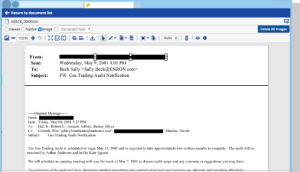It’s no secret that it’s important to remove personally identifiable information (PII) and other privileged information from case data before it’s produced in order to protect it from falling into the wrong hands. The amount of data to be reviewed prior to litigation continues to grow exponentially as more and more ESI enters into discovery requests, and with an increase in data to review, there’s a greater risk of accidentally disclosing PII. As the past few years have shown us, a breach of PII could have major consequences for a corporation or law firm. The problem with PII, however, is that many companies don’t sufficiently protect employee information within their own environments, and because there’s an increasing amount of overlap between employees’ work and personal lives, there are more opportunities for PII to creep up in unexpected places that are easily overlooked.
Think for a second about where you’d expect PII to show up. You’re probably thinking of HR records where employees’ Social Security numbers, addresses, and phone numbers are stored. PII is easy to spot when you’re checking in obvious places like HR files, but personal information can crop up in other places just as easily when data gets collected from a broad range of sources. If an employee has a payroll issue, they might email bank account information or Social Security numbers to the payroll department. Beyond company-related communications, they might even send scanned images of tax documents to their accountant or mortgage applications to buy a new home from their company email address rather than their personal email. If your case requires that you pull company emails between specified dates you might inadvertently collect this information. In addition to emails, employees might use the office scanner for personal documents that they then send from their personal emails – but if that file lives on the company server, it’s at risk of entering into discovery data. If there isn’t a sweep done for extraneous PII, these details will slip through the cracks and leak to opposing counsel. For this reason, it’s absolutely crucial to comb data not just for relevance and privilege, but also for PII.
It’s a slippery slope, not only because PII is ubiquitous and can easily hide in unexpected places, but there are many contributing factors that make it difficult to pin down and at the mercy of human error. While many individuals are sensitive to their own private information, the average person has low awareness of exactly what data constitutes PII and how it can be compromised, meaning they’re probably revealing their company’s and their own private information unknowingly. Even if employees are hyper-aware of sensitive data, PII differs from state to state, so definitions change constantly and new regulations are implemented frequently. What wasn’t sensitive last year might be sensitive this year, and all the information from last year is still sitting on your company servers.
PII laws are complicated and can widely vary depending on which state and country you’re in, so it’s important to have processes in place to help eliminate extraneous data. Arguing for proportionality to narrow the scope of the case will reduce the amount of unnecessary PII gathered, and making use of technology assisted review and the many e-discovery platforms that can quickly find specific data inputs will dramatically reduce the time it takes to comb through files for PII. There are also products that can assist in the identification and exclusion of PII hiding in your case data, including redaction automation tools. While there are many methods for securing PII, redaction is far and away the safest because it removes sensitive information completely. It cannot be recovered or uncoded, so it is really the best way to eliminate risk.
The sticky nature of PII means that security can’t be done on a case-by-case basis. It should be a part of company-wide best practices and have a well-vetted process in place to ensure data is properly protected, not just for individuals but the company as a whole. Implementing security policies and investing in redaction technologies can help you stay compliant and save time, resources, and your reputation.

